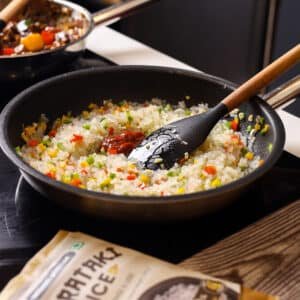
Guilty Pleasure, No Guilt: How Konjac Cake Redefines Dessert
- Andrew Yang
- 4 12 月, 2023
- 11:07 上午

Table of Contents
In the ever-evolving world of culinary delights, a new sensation has emerged to redefine how we view desserts. Say hello to Konjac Cake, a guilt-free indulgence taking the dessert scene by storm. If you’re tired of compromising between satisfying your sweet tooth and maintaining a healthy lifestyle, Konjac Cake might be the answer you’ve been searching for.
What is Konjac?
Before delving into the delectable world of Konjac Cake, let’s understand what Konjac is. Derived from the Konjac plant’s root, this natural, gelatinous substance has been a staple in Asian cuisine for centuries. Known for its low-calorie and high-fiber content, Konjac has recently become a healthy alternative in various food products.

The rise of Konjac Cake
Konjac Cake, a recent addition to the Konjac revolution, is causing a stir among health-conscious dessert enthusiasts. This guilt-free delight has become a game-changer, allowing individuals to indulge in their sweet cravings without compromising their wellness goals. Let’s explore why this Cake has become the latest obsession.
The health benefits of Konjac Cake

Low in calories
One of the standout features of Konjac Cake is its low-calorie content. Traditional desserts are often laden with sugars and unhealthy fats, contributing to excessive calorie intake. In contrast, this Cake allows you to enjoy a sweet treat without the guilt, thanks to its minimal calorie count.
High in fiber
Fiber is an essential component of a healthy diet, aiding in digestion and promoting a feeling of fullness. Konjac Cake, being rich in fiber, not only supports digestive health but also helps control appetite. This makes it an ideal choice for those looking to manage their weight while still relishing dessert.
Blood sugar regulation
Konjac has been associated with stabilizing blood sugar levels. So, the glucomannan fiber in Konjac slows down the absorption of sugar, preventing sudden spikes and crashes in blood sugar. Thus, for individuals with diabetes or those aiming to regulate their sugar intake, Konjac cake offers a sweet solution without compromising health.
Exploring the culinary delight: Konjac Cake

A symphony of flavors
Contrary to the misconception that healthy desserts lack flavor, Konjac cake boasts a delightful taste experience. Available in various flavors such as chocolate, vanilla, and fruit-infused, these cakes cater to a diverse range of palates. Whether you’re a chocolate lover or a fan of fruity delights, there’s a Konjac cake flavor to satisfy every craving.
Versatile in presentation
Konjac Cake is not just about flavors; it’s also a canvas for creative presentations. So, from intricate designs to simple elegance, these cakes can be molded into various shapes and sizes. The versatility of this Cake allows it to seamlessly integrate into both casual and upscale dining experiences, making it a favorite among chefs and home bakers alike.
Incorporating Konjac Cake into your lifestyle
A dessert for every occasion
Konjac Cake’s adaptability makes it suitable for various occasions. Whether it’s a birthday celebration, a family gathering, or a solo treat, this guilt-free dessert fits the bill. The ability to enjoy dessert without compromising on health makes Konjac Cake a staple in the repertoire of those who value both flavor and well-being.
DIY Konjac Cake: A fun culinary adventure
For culinary enthusiasts, making cake at home can be a rewarding experience. With readily available Konjac powder and a range of flavors to experiment with, crafting your guilt-free dessert becomes an enjoyable and creative endeavor. Plus, it allows you to tailor the sweetness level to your preference, giving you complete control over your dessert experience.
Where to find Konjac Cake
As the demand for guilt-free desserts rises, Konjac cake becomes more accessible. Health food stores, specialty dessert shops, and online platforms now offer various cake options. Embrace this culinary trend and explore the diverse world of guilt-free indulgence.
Conclusion
In the realm of desserts, Konjac Cake stands out as a beacon of innovation, proving that indulgence can be synonymous with health. As we celebrate the one-year mark of Konjac Cake’s emergence, it’s clear that this guilt-free pleasure has successfully carved a niche in the culinary landscape.
So, the next time you find yourself torn between satisfying your sweet tooth and sticking to your health goals, consider reaching for a slice of Cake. With its low-calorie, high-fiber goodness and a symphony of flavors, it’s a guilt-free pleasure that promises to redefine how you experience dessert. Here’s to a year of guilt-free indulgence and many more to come!
FAQs
1. What does konjac yam cake taste like?
Konjac yam cake, often made from the konjac plant’s corm, has a unique taste and texture. The flavor is relatively neutral, with a subtle earthiness, and it tends to absorb the flavors of the ingredients it’s cooked with. The texture is distinctive, offering a chewy and slightly gelatinous consistency. The versatility of this yam cake allows it to be used in various dishes, absorbing the flavors of sauces, broths, or other seasonings in which it is prepared. While it may not have a strong flavor on its own, its appeal often lies in its ability to complement and enhance the taste of the accompanying ingredients in a dish.
2. Is Konjac a gelatin?
No, konjac is not a gelatin. Gelatin is a protein obtained from animal collagen, typically derived from bones and skin. On the other hand, konjac is a plant-based substance extracted from the corm (bulb-like structure) of the konjac plant, scientifically known as Amorphophallus konjac. The primary component of konjac is glucomannan, a soluble fiber that gives it a gelatinous texture when hydrated. Due to its gelling properties, Konjac is a vegan and vegetarian alternative to gelatin in various food products and recipes. It provides a similar gel-like consistency without relying on animal-derived ingredients.
3. Is a Konjac a mushroom?
No, konjac is not a mushroom. Konjac, scientifically known as Amorphophallus konjac, is a plant that belongs to the family Araceae. Specifically, it is a perennial plant with a large, starchy corm (underground storage organ) utilized for various culinary and health-related purposes. On the other hand, mushrooms are a distinct group of fungi belonging to the kingdom of Fungi. While konjac and mushrooms have various cuisines and dietary supplements, they come from different biological classifications—konjac is a plant and mushroom belonging to the fungi kingdom.
4. Is Konjac a natural?
Yes, konjac is a natural substance from the konjac plant’s corm (underground storage organ), scientifically known as Amorphophallus konjac. The primary component of konjac is glucomannan, a soluble fiber. Konjac has a centuries-old history in Asian cuisines and traditional medicine. It is a natural ingredient in various food products, including konjac noodles and dietary supplements. However, when consuming products containing konjac or its derivatives, it’s essential to check for additional ingredients and processing methods to ensure the product’s overall natural and additive-free quality.













